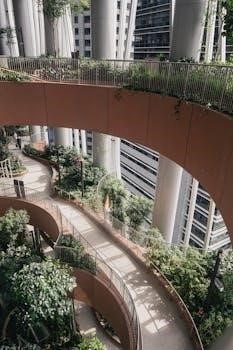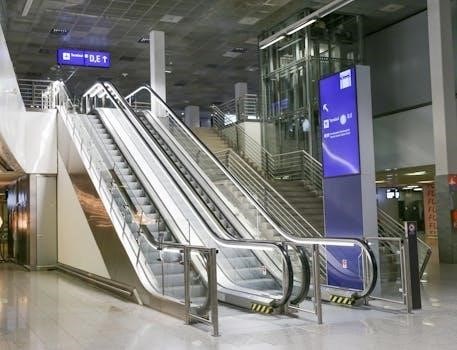
This section introduces the crucial role of pedestrian facility design in creating safe and accessible public spaces․ The focus is on planning, design, and operation, ensuring effective pedestrian accommodation along various roadways and facility types․ It highlights the importance of accessible design for all users․
Purpose of Pedestrian Facility Guidelines
The primary purpose of pedestrian facility guidelines is to offer comprehensive direction for the planning, design, and operation of pedestrian areas within public rights-of-way․ These guidelines aim to identify effective methods for accommodating pedestrians, encompassing diverse roadway and facility types․ They emphasize the importance of accessible design, ensuring usability for all individuals, including those with disabilities․ The guidelines also acknowledge the profound effect of land use and site design on pedestrian environments․ The information provided helps practitioners to navigate various design guides efficiently, finding necessary resources quickly․ Ultimately, these guidelines promote safer, more convenient, and inclusive pedestrian experiences by establishing clear standards and best practices․

Key Aspects of Planning Pedestrian Facilities
Effective pedestrian facility planning involves considering land use, site design impacts, and adherence to accessibility standards․ These elements ensure safe and convenient pedestrian environments, promoting inclusivity for all․
Land Use and Site Design Impact
Land use planning significantly influences pedestrian activity, creating demand for walkable environments․ Site design plays a vital role in accommodating pedestrians, ensuring connectivity between destinations․ The integration of pedestrian-friendly features, like sidewalks, crosswalks, and pedestrian zones, is essential in areas with high pedestrian traffic․ Mixed-use developments, with retail, residential, and recreational spaces within walking distance, encourage pedestrian activity․ The design should minimize obstacles, provide adequate lighting, and offer comfortable pedestrian zones, thereby fostering a safe and accessible environment․ Furthermore, land use policies that prioritize pedestrian access are crucial for promoting healthy and sustainable communities․ Effective integration of land use and site design creates vibrant, walkable neighborhoods․ These considerations are paramount for successful pedestrian-oriented planning․
Accessibility Standards and Regulations
Accessibility standards and regulations are fundamental to pedestrian facility design, ensuring usability by all people, including those with disabilities․ These standards, like the Public Rights-of-Way Accessibility Guidelines (PROWAG), dictate design elements such as smooth surfaces, continuous clear widths, and the absence of surface discontinuities․ Compliance with accessibility laws, regulations, and standards is essential for creating inclusive and equitable pedestrian environments․ These regulations often specify requirements for crosswalks, curb ramps, and detectable warnings to aid pedestrians with visual impairments․ Adhering to both state and federal standards ensures that pedestrian facilities are designed to accommodate diverse needs․ Accessibility is not just a legal requirement; it’s a crucial element of creating livable and inclusive communities․ Accessible design is a cornerstone of pedestrian facility design․

Design Elements for Pedestrian Areas
This section details the specific design elements crucial for effective pedestrian areas, focusing on creating safe and comfortable environments․ It includes elements such as on-street facilities and crosswalk design․
On-Street Pedestrian Facility Design
On-street pedestrian facility design is paramount in creating walkable and accessible urban environments․ It encompasses various elements, including sidewalks, buffers, and pedestrian zones․ The design should prioritize a smooth, planar surface with minimal discontinuities, ensuring ease of travel for all, including those with disabilities․ A continuous clear width of at least 4 feet is essential for comfortable pedestrian movement․ Furthermore, the presence of minimal obstacles and protruding objects is vital․ Clearly defined zones, including pedestrian, buffer/landscape, and frontage, are key components for effective street design․ These zones create a structured space, enhancing safety and the overall pedestrian experience․ Proper planning and implementation of these design principles are essential for successful on-street pedestrian facilities․ Additionally, it’s important to consider the integration of these elements with the surrounding context, ensuring a cohesive and functional design․
Crosswalk Design and Placement
Crosswalk design and placement are critical for pedestrian safety and accessibility․ These elements should be carefully considered within the broader context of street design․ Proper crosswalk design includes clear markings, such as painted lines and potentially contrasting pavement materials, to enhance visibility for both pedestrians and drivers․ The placement of crosswalks is equally crucial; they should be positioned at logical and convenient locations, often at intersections or mid-block where pedestrian activity is highest․ Furthermore, crosswalks should adhere to accessibility standards, ensuring that they are usable by individuals with disabilities․ Consideration should be given to the integration of traffic control devices like signals and timers, especially at busier intersections․ These devices can be paired with audible cues, benefiting pedestrians with sight impairments․ Finally, municipalities should amend ordinances to include requirements for crosswalks to guarantee that they are present where needed․ Consistent and well-thought-out crosswalk design contributes significantly to pedestrian safety․

Operational Considerations for Pedestrian Facilities
Effective operation of pedestrian facilities involves traffic control devices, timers, and consistent maintenance․ These elements ensure safety and accessibility for all users, emphasizing the practical aspects of pedestrian infrastructure;
Traffic Control Devices and Timers
The implementation of effective traffic control devices and timers is crucial for pedestrian safety and efficient traffic management․ These devices include pedestrian signals, crosswalk markings, and signage, all designed to guide both pedestrians and drivers․ Timers, often paired with audible cues, are essential for assisting pedestrians with visual impairments, ensuring they have sufficient time to cross safely․ Municipalities should consider amending ordinances to include requirements for crosswalks, enhancing pedestrian visibility and priority․ Proper timing of signals is also vital to prevent conflicts between pedestrians and vehicles, optimizing traffic flow and pedestrian movement․ These measures must be regularly reviewed and updated to reflect changes in traffic patterns and pedestrian needs, creating a safer and more accessible environment for everyone․
Maintenance of Pedestrian Facilities
Regular maintenance is paramount to ensure the long-term safety and usability of pedestrian facilities․ This includes timely repair of damaged sidewalks, removal of obstructions, and upkeep of crosswalk markings․ Proper maintenance prevents hazards such as uneven surfaces, potholes, and overgrown vegetation that can hinder pedestrian movement and accessibility․ Consistent cleaning of pedestrian areas is also necessary to maintain a pleasant and safe environment, free of debris and litter․ Furthermore, ensuring that traffic control devices are functioning correctly and are clearly visible is a critical part of ongoing maintenance․ Neglecting these aspects can compromise pedestrian safety, reduce accessibility, and lead to a decline in the overall pedestrian experience․ Therefore, a robust maintenance plan is essential for preserving the integrity of pedestrian facilities and promoting their consistent use․
Resources and Standards
This section highlights key resources and standards, including AASHTO guides and global street design guidelines, which provide crucial information for the planning, design, and operation of effective pedestrian facilities․
AASHTO Guides and Standards
The American Association of State Highway and Transportation Officials (AASHTO) provides essential technical standards, design specifications, and guides for transportation infrastructure․ These resources are crucial for professionals involved in the construction, design, and maintenance of pedestrian facilities․ The AASHTO guide for the planning, design, and operation of pedestrian facilities is a key document, offering comprehensive guidance on accommodating pedestrians in public rights-of-way․ It addresses various roadway and facility types, ensuring effective measures are implemented to enhance pedestrian safety and accessibility․ The guide includes the latest research and technological advancements, impacting pedestrian facility design and operation․ Furthermore, AASHTO’s online store is a valuable source for accessing these standards and guides, which cover a wide range of topics related to transportation infrastructure, including highways, streets, bridges, and public transport․
Global Street Design Guidance
The Global Street Design Guide, a collaborative effort by the Global Designing Cities Initiative and the National Association of City Transportation Officials, establishes a global baseline for street design․ This guide provides crucial insights into creating pedestrian-friendly environments, focusing on the planning, design, and operation of streets to accommodate all users, particularly pedestrians․ It emphasizes the importance of accessible design principles, ensuring that pedestrian facilities are usable by all people, including those with disabilities․ The guide acts as a timely resource, promoting best practices for integrating pedestrian needs into street design․ It complements other resources, such as the AASHTO guides, offering a comprehensive perspective on creating safe, functional, and vibrant pedestrian spaces worldwide․ This guidance helps practitioners quickly access essential information, streamlining the process of designing better urban environments for pedestrians․

Improving Existing Pedestrian Environments
This section focuses on strategies for enhancing current pedestrian areas․ It covers retrofitting existing facilities and implementing specific improvement strategies to create safer, more accessible, and convenient walking environments․
Retrofitting Existing Facilities
Retrofitting existing pedestrian facilities often presents unique challenges, requiring careful consideration of site constraints and existing infrastructure․ This process involves adapting current spaces to meet modern safety and accessibility standards․ It’s essential to prioritize improvements that address the most pressing needs, such as widening sidewalks, smoothing surfaces, and ensuring proper drainage․ Retrofitting also includes adding or modifying curb ramps, crosswalks, and pedestrian signals to enhance safety and visibility․ The goal is to create a pedestrian environment that is not only functional but also promotes walkability and connectivity within the community․ This may involve creative solutions to integrate new elements into established urban landscapes, respecting historical and architectural context while meeting current design guidelines․
Pedestrian Facility Improvement Strategies
Implementing effective strategies for improving pedestrian facilities requires a multi-faceted approach, encompassing various aspects of design and management․ Strategies should focus on reducing vehicle speeds, improving driver and pedestrian compliance with traffic regulations, and enhancing pedestrian crossing safety․ This involves the implementation of traffic calming measures, clear signage, and well-marked crosswalks, which contribute to a more secure pedestrian environment․ Furthermore, improvements should include regular maintenance, addressing issues like surface irregularities and obstructions promptly․ A key aspect is ensuring facilities meet accessibility standards, making them usable for all people․ Improvement strategies also should consider the integration of pedestrian-friendly street furniture, such as benches and plantings, to enhance comfort and the overall experience of walking․


